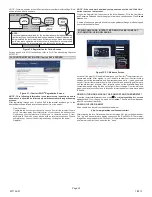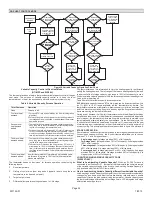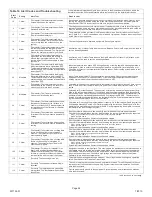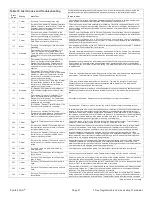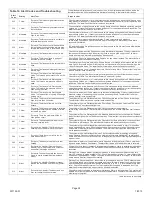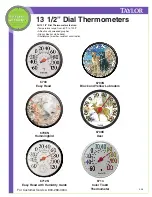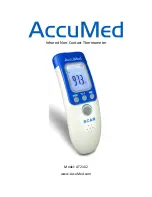
507152-01
7/2013
Page 28
Table 10. Alert Codes and Troubleshooting
Critical alerts are displayed on Home (user) screen, in the Homeowner alert button, and in the
Installer alert button. Minor and Moderate alerts are found only in the Installer alert button.
Alert
Code
Steps to clear
Alert Text
Priority
225
Critical
(Furnace) The furnace high pressure switch
is failing to close.
Check pressure (inches w.c.) of high pressure switch closing during a heat call. Measure oper
ating pressure (inches w.c.). Inspect vent and combustion air inducer for correct operation and
restriction. The alarm/fault clears after the issue is corrected.
226
Critical
(Furnace) The furnace high pressure switch
is stuck closed.
Check operation of high pressure switch closing during a heat call. Measure operating pressure
(inches w.c.). Inspect vent and combustion air inducer for correct operation and restriction. The
alarm/fault clears after the issue is corrected.
227
Moderate
(Furnace) The furnace low pressure switch is
open in run mode.
Check pressure (inches w.c.) of low pressure switch closing during a heat call. Measure operat
ing pressure (inches w.c.). Inspect vent and combustion air inducer for correct operation and
restriction. The alarm/fault clears after the issue is corrected.
228
Moderate
(Furnace) The furnace control is not able to
calibrate the pressure switch.
Unable to perform pressure switch calibration. Check vent system and pressure
switch wiring connections. Check the drain trap for blockage. The alarm/fault clears after a
successful calibration.
229
Minor
(Furnace) The furnace control has switched
to high fire ignition because the low fire pres
sure switch did not close in the allowed time.
IFC switched to high fire ignition because low fire pressure switch did not close in allowed time.
No action is needed.
240
Moderate
(Furnace) The furnace flame current is low.
Check micro-amperes of the flame sensor using thermostat diagnostics. Clean or replace the
flame sensor. Measure voltage of neutral to ground to ensure good unit ground. The alarm
clears after a proper micro-amp reading has been sensed.
241
Critical
(Furnace) The furnace flame is going out
while the furnace is heating.
Shut off gas. Check for a gas valve leak. Replace the gas valve if needed. The alarm/fault will
clear when a heat call ends successfully.
250
Moderate
(Furnace) The furnace primary limit switch is
open.
Check for proper firing rate on furnace. Ensure there is no blockage in the furnace and the duct
work. Check for proper air flow. If limit switch is not closed within 3 minutes, the unit will go into
1-hour Watchguard mode. The alarm/fault will clear when a heat call ends successfully.
252
Moderate
(Furnace) The furnace discharge air-temper
ature is high.
Check temperature rise, air flow and input rate. Check for dirty filters. The alarm/fault will clear
when a heat call ends successfully.
270
Critical
(Furnace) The furnace is in Watchguard
mode. The furnace igniter cannot turn on the
flame.
Check for proper gas flow. Ensure that igniter is lighting burner. Check flame sensor current.
Check for dirty filters. The alarm/fault will clear on successful ignition.
271
Critical
(Furnace) The furnace is in Watchguard
mode. The furnace low pressure switch is
open.
Check pressure (inches w.c.) of low pressure switch closing during a heat call. Measure operat
ing pressure (inches w.c.). Inspect vent and combustion air inducer for correct operation and
restriction. The alarm/fault will clear on successful ignition.
272
Critical
(Furnace) The furnace is in Watchguard
mode. The furnace low pressure switch is
open during run mode.
Check operation of low pressure switch to see if it is stuck open during a heat call. Measure
operating pressure (inches w.c.). Inspect vent and combustion air inducer for correct operation
and restriction. The alarm/fault will clear when a heat call ends successfully.
273
Critical
(Furnace) The furnace is in Watchguard
mode. The furnace flame is going off during a
heating cycle.
Check micro-amperes of flame sensor using thermostat diagnostics. Clean or replace sensor.
Measure voltage of neutral to ground to ensure good unit ground. The alarm/fault will clear
when a heat call ends successfully.
274
Critical
(Furnace) The furnace limit switch has been
open for more than 3 minutes.
The system will go into Watchguard mode. Check firing rate and air flow. Check for blockage.
The alarm/fault will clear when a heat call ends successfully.
275
Critical
(Furnace) The furnace flame is out of se
quence.
The system will go into Watchguard mode. Shut off gas. Check for gas valve leak. The alarm/
fault will clear on next successful ignition.
276
Critical
(Furnace) The furnace is not able to calibrate
or the high pressure switch opened or failed
to close in run mode.
The system will go into Watchguard mode. Check vent system and pressure
switch wiring connections. The fault/alarm will clear when the furnace calibrates itself success
fully.
290
Critical
(Furnace) There is a problem with the fur
nace ignition circuit.
The system will go into Watchguard mode. Measure resistance of hot surface igniter. Replace
the hot surface ignitor it is not within specifications. The alarm/fault will clear on next successful
ignition.
291
Critical
(Furnace) The heating airflow is below the
minimum required level.
The system will go into Watchguard mode. Check for dirty filters and other air flow restrictions.
Check blower performance. The alarm/fault will clear when a heat call ends successfully.
292
Critical
(Furnace / Air Handler) The
(furnace or air-
handler)
indoor blower motor will not start.
The system will go into Watchguard mode. Indoor blower motor unable to start. This could be
due to seized bearing, stuck wheel, obstruction etc. Replace motor or wheel if assembly does
not operate or meet performance standards. The alarm/fault clears after the indoor blower
motor starts successfully.
294
Critical
(Furnace) There is over current in the fur
nace inducer motor.
The system will go into Watchguard mode. Check combustion blower bearings, wiring and
amps. Replace if does not operate or does not meet performance standards. The alarm/fault
clears after inducer current is sensed to be in-range after the ignition following the Watchguard
mode or reset.
295
Minor
(Furnace) The indoor blower motor is over
heating.
Indoor blower motor over temperature (motor tripped on internal protector). Check motor bear
ings and amps. Replace if necessary. The alarm/fault clears after blower demand is satisfied.
310
Critical
(Furnace / Air Handler / Damper Control
Module) There is a problem with
(furnace or
air-handler)
discharge air sensor.
Compare outdoor sensor resistance to temperature/resistance charts in installation instructions.
Replace sensor if necessary. The alarm/fault is cleared 30 seconds after fault is detected as
recovered.
311
Minor
(Furnace) The heat firing rate has been re
duced to match available airflow (cutback
mode).
Warning Only. Furnace blower in cutback mode due to restricted airflow. Reduce firing rate
every 60 seconds to match available CFM. Check filter and duct system. To clear, replace filter
if needed or repair/add duct. 2-stage controls will reduce firing rate to 1st stage. The alarm/fault
clears when a heat call finishes successfully.
312
Minor
(Furnace / Air Handler) The blower cannot
provide the requested CFM due to high stat
ic.
Warning Only. Restricted airflow - Indoor blower is running at a reduced CFM (Cutback Mode -
The variable speed motor has pre-set speed and torque limiters to protect the motor from dam
age caused by operating outside of design parameters (0 to 0.8” e.g.. total external static pres
sure). Check filter and duct system. To clear, replace filter if needed or repair/add duct. The
alarm/fault is cleared after the current service demand is satisfied.
313
Minor
(Furnace / Air Handler) The indoor and out
door unit capacities do not match.
Check for proper configuring in installation instructions. Alarm is just a warning. The system will
operate, but might not meet efficiency and capacity parameters. The alarm will clear after com
missioning is complete.
table continued on next page







